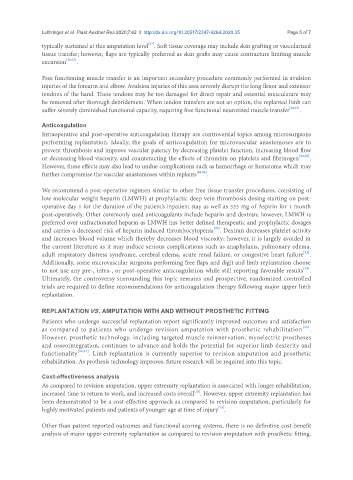Page 481 - Read Online
P. 481
Luthringer et al. Plast Aesthet Res 2020;7:42 I http://dx.doi.org/10.20517/2347-9264.2020.35 Page 5 of 7
[27]
typically sustained at this amputation level . Soft tissue coverage may include skin grafting or vascularized
tissue transfer; however, flaps are typically preferred as skin grafts may cause contracture limiting muscle
excursion [26,27] .
Free functioning muscle transfer is an important secondary procedure commonly performed in avulsion
injuries of the forearm and elbow. Avulsion injuries of this area severely disrupt the long flexor and extensor
tendons of the hand. These tendons may be too damaged for direct repair and essential musculature may
be removed after thorough debridement. When tendon transfers are not an option, the replanted limb can
suffer severely diminished functional capacity, requiring free functional neurotized muscle transfer [26,27] .
Anticoagulation
Intraoperative and post-operative anticoagulation therapy are controversial topics among microsurgeons
performing replantation. Ideally, the goals of anticoagulation for microvascular anastomoses are to
prevent thrombosis and improve vascular patency by decreasing platelet function, increasing blood flow
or decreasing blood viscosity, and counteracting the effects of thrombin on platelets and fibrinogen [28,29] .
However, these effects may also lead to undue complications such as hemorrhage or hematoma which may
further compromise the vascular anastomoses within replants [28,30] .
We recommend a post-operative regimen similar to other free tissue transfer procedures, consisting of
low molecular weight heparin (LMWH) at prophylactic deep vein thrombosis dosing starting on post-
operative day 1 for the duration of the patient’s inpatient stay as well as 325 mg of Aspirin for 1 month
post-operatively. Other commonly used anticoagulants include heparin and dextran; however, LMWH is
preferred over unfractionated heparin as LMWH has better defined therapeutic and prophylactic dosages
[28]
and carries a decreased risk of heparin induced thrombocytopenia . Dextran decreases platelet activity
and increases blood volume which thereby decreases blood viscosity; however, it is largely avoided in
the current literature as it may induce serious complications such as anaphylaxis, pulmonary edema,
[31]
adult respiratory distress syndrome, cerebral edema, acute renal failure, or congestive heart failure .
Additionally, some microvascular surgeons performing free flaps and digit and limb replantation choose
[32]
to not use any pre-, intra-, or post-operative anticoagulation while still reporting favorable results .
Ultimately, the controversy surrounding this topic remains and prospective, randomized controlled
trials are required to define recommendations for anticoagulation therapy following major upper limb
replantation.
REPLANTATION VS. AMPUTATION WITH AND WITHOUT PROSTHETIC FITTING
Patients who undergo successful replantation report significantly improved outcomes and satisfaction
[33]
as compared to patients who undergo revision amputation with prosthetic rehabilitation .
However, prosthetic technology, including targeted muscle reinnervation, myoelectric prostheses
and osseointegration, continues to advance and holds the potential for superior limb dexterity and
functionality [33,34] . Limb replantation is currently superior to revision amputation and prosthetic
rehabilitation. As prothesis technology improves, future research will be required into this topic.
Cost-effectiveness analysis
As compared to revision amputation, upper extremity replantation is associated with longer rehabilitation,
[12]
increased time to return to work, and increased costs overall . However, upper extremity replantation has
been demonstrated to be a cost-effective approach as compared to revision amputation, particularly for
[35]
highly motivated patients and patients of younger age at time of injury .
Other than patient reported outcomes and functional scoring systems, there is no definitive cost-benefit
analysis of major upper extremity replantation as compared to revision amputation with prosthetic fitting.

